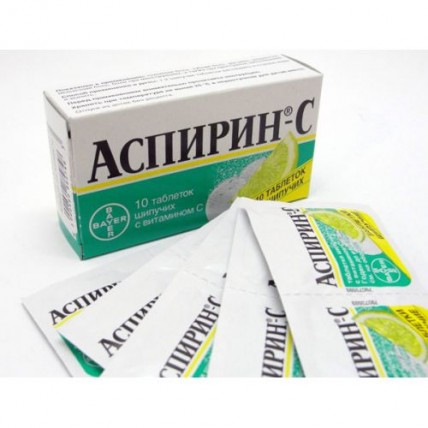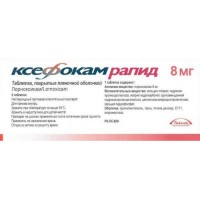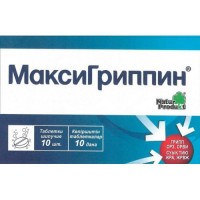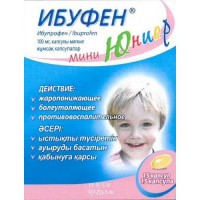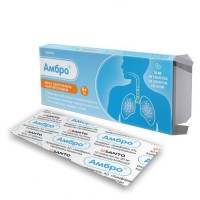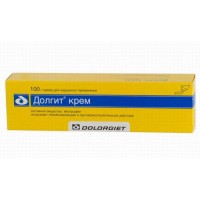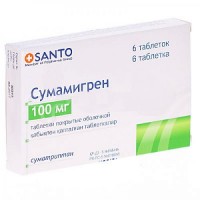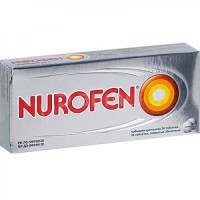Aspirin-C 10s effervescent tablets
- $13.60
Sku:
7fa53c527078
The instruction for use
of medicine for experts
АСПИРИН® - the C
Trade name
of Aspirin® - the C
International unlicensed name
Is not present
the Dosage form
the Sparkling
tablets Structure One Sparkling Tablet contains
active agents: acetylsalicylic acid of 400 mg, ascorbic acid (vitamin C) of 240 mg,
excipients: sodium citrate anhydrous, sodium carbonate monosubstituted, citric acid anhydrous, sodium carbonate anhydrous.
The description
the Round, flat, mown to edge tablets of white color, with a print in the form of the logo of BAYER a cross on the one hand.
Pharmacotherapeutic group
Analgetics-antipyretics. Acetylsalicylic acid in a combination with other drugs.
N02BA51 code
the Pharmacological
Pharmacokinetics At properties intake acetylsalicylic acid is quickly soaked up by automatic telephone exchange from digestive tract. Presence of food at a stomach considerably changes absorption of acetylsalicylic acid. Acetylsalicylic acid is distributed in the majority of fabrics and fluid mediums of an organism. Gets through a blood-brain barrier (GEB).
It is metabolized in a liver by hydrolysis with formation of salicylic acid with the subsequent conjugation with glycine or a glucuronide. About 80% of salicylic acid contact proteins of blood plasma.
T1/2 of acetylsalicylic acid makes about 15 min., salicylic acid – about 3 h. It is removed by kidneys mainly in the form of salicylic acid.
After intake, ascorbic acid is soaked up in a small intestine with participation sodium - the dependent transport system, absorption is not proportional to the entered dose. Cmax after intake is reached in 4 hours.
Easily gets into leukocytes, thrombocytes, and then - into all fabrics, it is deposited in a back share of a hypophysis, bark of adrenal glands, a liver, a brain, lungs, kidneys, an intestines wall, heart, muscles, a spleen, a pancreas. It is metabolized mainly in a liver. The main metabolites of ascorbic acid are removed with urine.
The pharmacodynamics
Acetylsalicylic acid (ASK) belongs to group of non-steroidal anti-inflammatory drugs (NPVP) and possesses anesthetic, febrifugal and anti-inflammatory action and also oppresses aggregation of thrombocytes. The mechanism of action is connected with oppression of activity of COG – the main enzyme of metabolism of arachidonic acid, being the predecessor of prostaglandins which play a major role in pathogenesis of inflammation, pain and fever.
The significant analgeziruyushchy effect of acetylsalicylic acid is caused by two mechanisms: peripheral (indirectly, through suppression of synthesis of prostaglandins) and central (the caused inhibition of synthesis of prostaglandins in the central and peripheral nervous system).
Owing to reduction of products of prostaglandins their influence on the centers of thermal control decreases.
Irreversible disturbance of synthesis in thrombocytes of A2 thromboxane causes anti-modular effect of acetylsalicylic acid.
At use in the raised doses acetylsalicylic acid can inhibit synthesis of a prothrombin in a liver and increase a prothrombin time.
Ascorbic acid - water-soluble vitamin, plays an important role in regulation of oxidation-reduction processes, carbohydrate metabolism, blood clotting, angenesis, promotes increase in body resistance.
Ascorbic acid is a component of the system protecting an organism from harmful effects of free radicals and other oxidizers and also plays an important role in inflammatory processes and in the mechanism of action of leukocytes.
Ascorbic acid plays an important role in the course of synthesis of intracellular mucopolysaccharides which along with collagenic fibers provide durability of walls of capillaries.
Indications
- a pain syndrome of various origin at adults (headache, a toothache, a sore throat, migraine, muscular and articulate pain, a dorsodynia, menstrual pains)
- the increased body temperature at adults and children are more senior than 15 years in catarrhal and other infectious and inflammatory diseases.
To Accept a route of administration and doses inside. To dissolve a sparkling tablet in a glass of water and to drink. At a pain syndrome of weak and average intensity and feverish states the single dose makes 1-2 sparkling tablets with an interval of 4-8 hours, the maximum single dose - 2 sparkling tablets, the maximum daily dose should not exceed 10 sparkling tablets.
Side effects
- abdominal pain, nausea, vomiting, obvious (vomiting with blood, a tar-like chair) or the hidden symptoms of gastrointestinal bleeding which can lead to an iron deficiency anemia erosive cankers (including with perforation) digestive tract
- increase in activity of hepatic transaminases
- dizziness, sonitus (usually are overdose symptoms)
- the increased risk of bleedings
- urticaria, anaphylactic reactions, a bronchospasm, a Quincke's edema
- at use in high doses a hyperoxaluria and formation of urinary stones from calcium oxalate, damage of the glomerular device of kidneys.
Contraindications
- a digestive tract canker
- hemorrhagic diathesis
- hypersensitivity to ASK, other salicylates or any excipients of drug
- the bronchial asthma induced by intake of salicylates and NPVP
- the combined use with a methotrexate in a dose of 15 mg a week and more
- the I and III trimesters of pregnancy and the period of a lactation
- at the accompanying therapy by anticoagulants
- to children up to 15 years with the acute respiratory diseases caused by viral infections because of risk of development of a syndrome to Reja (encephalopathy and acute fat dystrophy of a liver with acute development of a liver failure).
With care
in the presence in the anamnesis: digestive tract ulcers, including a chronic or recurrent peptic ulcer and also gastrointestinal bleedings, allergic reactions to NPVP and other drugs, bronchial asthma, hay fever, a polypose of a nose, chronic diseases of respiratory organs, in a renal failure and a liver, gout, a hyperuricemia, the II trimester of pregnancy.
Medicinal interactions
As anti-inflammatory drugs reduce renal clearance of a methotrexate and break linking of a methotrexate with proteins of plasma, the combined use of acetylsalicylic acid and a methotrexate in a dose of ≥15 mg a week contraindicated.
At the combined use of acetylsalicylic acid with anticoagulants (coumarin, heparin) the risk of bleeding in connection with dysfunction of thrombocytes and damage mucous digestive tract increases.
Because of mutual strengthening of effect at use together with high doses (3 ≥ g/day) other NPVP containing salicylates the risk of cankers and gastrointestinal bleedings increases.
At the combined use with uricosuric drugs (benzbromaron, probenitsid) decrease in uricosuric effect can be noted (in connection with competitive removal of uric acid kidneys).
Atsetilsplitsilovy acid increases concentration of digoxin in blood plasma.
High doses of acetylsalicylic acid enhance hypoglycemic effect of anti-diabetic drugs (insulin, sulphonylurea drugs).
At the combined appointment with other antiagregatnymi / thrombolytic drugs (tiklopidin) the risk of bleedings increases.
At combined use of acetylsalicylic acid in doses ≥ 3 g/days with diuretics the decrease in glomerular filtration is noted (in connection with reduction of synthesis of prostaglandins kidneys).
System glucocorticoids (except the hydrocortisone applied as the substituting therapy in Addison's disease) reduce concentration of salicylates in blood plasma that increases risk of overdose of salicylates after the treatment termination by glucocorticosteroids.
Against the background of the combined use of acetylsalicylic acid in doses ≥ 3 g/days and inhibitors of angiotensin-converting enzyme (APF) decrease in glomerular filtration of APF inhibitors is noted that is followed by reduction of their antihypertensive action.
Acetylsalicylic acid strengthens toxic effect of valproic acid.
Alcohol increases a bleeding time and the damaging effect of acetylsalicylic acid by a mucous membrane of a GIT.
Ascorbic acid increases concentration in blood of salicylates (increases risk of a crystalluria), ethinylestradiol, benzylpenicillin and tetracyclines, reduces – oral contraceptives.
Reduces anti-coagulative effect of derivatives of coumarin.
Improves absorption in intestines of iron preparations.
Increases the general Cl of alcohol.
Drugs of a quinolinic row, Calcii chloridum, salicylates, corticosteroids at prolonged use exhaust reserves of ascorbic acid.
Special instructions
Acetylsalicylic acid can provoke an attack of bronchial asthma or other allergic reactions. Risk factors is existence at the patient of bronchial asthma in the anamnesis, hay fever, a polypose of a nose, chronic diseases of respiratory organs and also allergic reactions to other drugs (for example, an itching, urticaria, other skin reactions).
The ability of acetylsalicylic acid to suppress aggregation of thrombocytes can result in the increased bleeding in time and after surgical interventions (including small, for example, extraction of tooth). The risk of bleedings increases at use of ASK in a high dose.
In low doses acetylsalicylic acid reduces extraction of uric acid that can lead to development of gout in patients with initially low level of its excretion that can become the reason of a bad attack of gout at predisposed patients.
One dose of drug contains 933 mg of sodium that should be considered to the patients keeping to a saltless diet.
Use during pregnancy and a lactation
Use of salicylates for the first time 3 months of pregnancy is associated with the increased frequency of defects of fetation (the split sky, heart diseases). However, when using drug in therapeutic doses risk of congenital defects of development low. In the last trimester of pregnancy salicylates in a high dose (more than 300 mg/days) cause slowing down of patrimonial activity, lengthening of childbirth, premature closing of an arterial channel in a fruit, the increased bleeding in mother and a fruit, and appointment just before childbirth can cause intracraneal hemorrhages, especially in premature children.
In the II trimester of pregnancy it is possible to appoint salicylates only taking into account strict assessment of risk and advantage.
Salicylates and their metabolites in small amounts get into breast milk. Accidental intake of salicylates in the period of a lactation is not followed by development of side reactions in the child and does not demand the breastfeeding termination. However at prolonged use of drug or appointment it in a high dose feeding by a breast should be stopped immediately.
Influence on driving of motor transport and control of mechanisms at use of drug was not noted.
The overdose
Overdose is especially dangerous at elderly patients and at children.
Sonitus, feeling of decrease in hearing, a headache, dizziness, block are characteristic of overdose of moderate degree.
Symptoms can be controlled by a drug dose decline.
Fever, a hyperventilation, a ketosis, a respiratory alkalosis, a metabolic acidosis, a coma, cardiovascular shock, respiratory insufficiency, a hypoglycemia of heavy degree are characteristic of overdose of heavy degree.
Actions of the emergency help
Urgent hospitalization in specialized department for performing the emergency therapy - gastric lavage, prescribing of activated carbon, determination of acid-base balance, an alkaline diuresis before obtaining values rn urine within 7.5-8.0 mg/l (3.6 mmol/l) at adults and 300 mg/l (2.2 mmol/l) are at children, compensation of losses of liquid, symptomatic treatment.
In a serious poisoning carrying out a hemodialysis is possible.
A form of release and packing
On 10 sparkling tablets in planimetric bezjyacheykovy packing together with the instruction for use in a cardboard pack.
To Store storage conditions at a temperature not above +25 °C.
To store out of children's reach!
3 years
not to use a period of storage after the term specified on packing.
Prescription status
Without prescription
of Proizvoditel Bayer Konsyyumer Ker AG, Switzerland
Proizvedeno Bayer Bitterfeld GmbH, Germany
To develop
of medicine for experts
АСПИРИН® - the C
Trade name
of Aspirin® - the C
International unlicensed name
Is not present
the Dosage form
the Sparkling
tablets Structure One Sparkling Tablet contains
active agents: acetylsalicylic acid of 400 mg, ascorbic acid (vitamin C) of 240 mg,
excipients: sodium citrate anhydrous, sodium carbonate monosubstituted, citric acid anhydrous, sodium carbonate anhydrous.
The description
the Round, flat, mown to edge tablets of white color, with a print in the form of the logo of BAYER a cross on the one hand.
Pharmacotherapeutic group
Analgetics-antipyretics. Acetylsalicylic acid in a combination with other drugs.
N02BA51 code
the Pharmacological
Pharmacokinetics At properties intake acetylsalicylic acid is quickly soaked up by automatic telephone exchange from digestive tract. Presence of food at a stomach considerably changes absorption of acetylsalicylic acid. Acetylsalicylic acid is distributed in the majority of fabrics and fluid mediums of an organism. Gets through a blood-brain barrier (GEB).
It is metabolized in a liver by hydrolysis with formation of salicylic acid with the subsequent conjugation with glycine or a glucuronide. About 80% of salicylic acid contact proteins of blood plasma.
T1/2 of acetylsalicylic acid makes about 15 min., salicylic acid – about 3 h. It is removed by kidneys mainly in the form of salicylic acid.
After intake, ascorbic acid is soaked up in a small intestine with participation sodium - the dependent transport system, absorption is not proportional to the entered dose. Cmax after intake is reached in 4 hours.
Easily gets into leukocytes, thrombocytes, and then - into all fabrics, it is deposited in a back share of a hypophysis, bark of adrenal glands, a liver, a brain, lungs, kidneys, an intestines wall, heart, muscles, a spleen, a pancreas. It is metabolized mainly in a liver. The main metabolites of ascorbic acid are removed with urine.
The pharmacodynamics
Acetylsalicylic acid (ASK) belongs to group of non-steroidal anti-inflammatory drugs (NPVP) and possesses anesthetic, febrifugal and anti-inflammatory action and also oppresses aggregation of thrombocytes. The mechanism of action is connected with oppression of activity of COG – the main enzyme of metabolism of arachidonic acid, being the predecessor of prostaglandins which play a major role in pathogenesis of inflammation, pain and fever.
The significant analgeziruyushchy effect of acetylsalicylic acid is caused by two mechanisms: peripheral (indirectly, through suppression of synthesis of prostaglandins) and central (the caused inhibition of synthesis of prostaglandins in the central and peripheral nervous system).
Owing to reduction of products of prostaglandins their influence on the centers of thermal control decreases.
Irreversible disturbance of synthesis in thrombocytes of A2 thromboxane causes anti-modular effect of acetylsalicylic acid.
At use in the raised doses acetylsalicylic acid can inhibit synthesis of a prothrombin in a liver and increase a prothrombin time.
Ascorbic acid - water-soluble vitamin, plays an important role in regulation of oxidation-reduction processes, carbohydrate metabolism, blood clotting, angenesis, promotes increase in body resistance.
Ascorbic acid is a component of the system protecting an organism from harmful effects of free radicals and other oxidizers and also plays an important role in inflammatory processes and in the mechanism of action of leukocytes.
Ascorbic acid plays an important role in the course of synthesis of intracellular mucopolysaccharides which along with collagenic fibers provide durability of walls of capillaries.
Indications
- a pain syndrome of various origin at adults (headache, a toothache, a sore throat, migraine, muscular and articulate pain, a dorsodynia, menstrual pains)
- the increased body temperature at adults and children are more senior than 15 years in catarrhal and other infectious and inflammatory diseases.
To Accept a route of administration and doses inside. To dissolve a sparkling tablet in a glass of water and to drink. At a pain syndrome of weak and average intensity and feverish states the single dose makes 1-2 sparkling tablets with an interval of 4-8 hours, the maximum single dose - 2 sparkling tablets, the maximum daily dose should not exceed 10 sparkling tablets.
Side effects
- abdominal pain, nausea, vomiting, obvious (vomiting with blood, a tar-like chair) or the hidden symptoms of gastrointestinal bleeding which can lead to an iron deficiency anemia erosive cankers (including with perforation) digestive tract
- increase in activity of hepatic transaminases
- dizziness, sonitus (usually are overdose symptoms)
- the increased risk of bleedings
- urticaria, anaphylactic reactions, a bronchospasm, a Quincke's edema
- at use in high doses a hyperoxaluria and formation of urinary stones from calcium oxalate, damage of the glomerular device of kidneys.
Contraindications
- a digestive tract canker
- hemorrhagic diathesis
- hypersensitivity to ASK, other salicylates or any excipients of drug
- the bronchial asthma induced by intake of salicylates and NPVP
- the combined use with a methotrexate in a dose of 15 mg a week and more
- the I and III trimesters of pregnancy and the period of a lactation
- at the accompanying therapy by anticoagulants
- to children up to 15 years with the acute respiratory diseases caused by viral infections because of risk of development of a syndrome to Reja (encephalopathy and acute fat dystrophy of a liver with acute development of a liver failure).
With care
in the presence in the anamnesis: digestive tract ulcers, including a chronic or recurrent peptic ulcer and also gastrointestinal bleedings, allergic reactions to NPVP and other drugs, bronchial asthma, hay fever, a polypose of a nose, chronic diseases of respiratory organs, in a renal failure and a liver, gout, a hyperuricemia, the II trimester of pregnancy.
Medicinal interactions
As anti-inflammatory drugs reduce renal clearance of a methotrexate and break linking of a methotrexate with proteins of plasma, the combined use of acetylsalicylic acid and a methotrexate in a dose of ≥15 mg a week contraindicated.
At the combined use of acetylsalicylic acid with anticoagulants (coumarin, heparin) the risk of bleeding in connection with dysfunction of thrombocytes and damage mucous digestive tract increases.
Because of mutual strengthening of effect at use together with high doses (3 ≥ g/day) other NPVP containing salicylates the risk of cankers and gastrointestinal bleedings increases.
At the combined use with uricosuric drugs (benzbromaron, probenitsid) decrease in uricosuric effect can be noted (in connection with competitive removal of uric acid kidneys).
Atsetilsplitsilovy acid increases concentration of digoxin in blood plasma.
High doses of acetylsalicylic acid enhance hypoglycemic effect of anti-diabetic drugs (insulin, sulphonylurea drugs).
At the combined appointment with other antiagregatnymi / thrombolytic drugs (tiklopidin) the risk of bleedings increases.
At combined use of acetylsalicylic acid in doses ≥ 3 g/days with diuretics the decrease in glomerular filtration is noted (in connection with reduction of synthesis of prostaglandins kidneys).
System glucocorticoids (except the hydrocortisone applied as the substituting therapy in Addison's disease) reduce concentration of salicylates in blood plasma that increases risk of overdose of salicylates after the treatment termination by glucocorticosteroids.
Against the background of the combined use of acetylsalicylic acid in doses ≥ 3 g/days and inhibitors of angiotensin-converting enzyme (APF) decrease in glomerular filtration of APF inhibitors is noted that is followed by reduction of their antihypertensive action.
Acetylsalicylic acid strengthens toxic effect of valproic acid.
Alcohol increases a bleeding time and the damaging effect of acetylsalicylic acid by a mucous membrane of a GIT.
Ascorbic acid increases concentration in blood of salicylates (increases risk of a crystalluria), ethinylestradiol, benzylpenicillin and tetracyclines, reduces – oral contraceptives.
Reduces anti-coagulative effect of derivatives of coumarin.
Improves absorption in intestines of iron preparations.
Increases the general Cl of alcohol.
Drugs of a quinolinic row, Calcii chloridum, salicylates, corticosteroids at prolonged use exhaust reserves of ascorbic acid.
Special instructions
Acetylsalicylic acid can provoke an attack of bronchial asthma or other allergic reactions. Risk factors is existence at the patient of bronchial asthma in the anamnesis, hay fever, a polypose of a nose, chronic diseases of respiratory organs and also allergic reactions to other drugs (for example, an itching, urticaria, other skin reactions).
The ability of acetylsalicylic acid to suppress aggregation of thrombocytes can result in the increased bleeding in time and after surgical interventions (including small, for example, extraction of tooth). The risk of bleedings increases at use of ASK in a high dose.
In low doses acetylsalicylic acid reduces extraction of uric acid that can lead to development of gout in patients with initially low level of its excretion that can become the reason of a bad attack of gout at predisposed patients.
One dose of drug contains 933 mg of sodium that should be considered to the patients keeping to a saltless diet.
Use during pregnancy and a lactation
Use of salicylates for the first time 3 months of pregnancy is associated with the increased frequency of defects of fetation (the split sky, heart diseases). However, when using drug in therapeutic doses risk of congenital defects of development low. In the last trimester of pregnancy salicylates in a high dose (more than 300 mg/days) cause slowing down of patrimonial activity, lengthening of childbirth, premature closing of an arterial channel in a fruit, the increased bleeding in mother and a fruit, and appointment just before childbirth can cause intracraneal hemorrhages, especially in premature children.
In the II trimester of pregnancy it is possible to appoint salicylates only taking into account strict assessment of risk and advantage.
Salicylates and their metabolites in small amounts get into breast milk. Accidental intake of salicylates in the period of a lactation is not followed by development of side reactions in the child and does not demand the breastfeeding termination. However at prolonged use of drug or appointment it in a high dose feeding by a breast should be stopped immediately.
Influence on driving of motor transport and control of mechanisms at use of drug was not noted.
The overdose
Overdose is especially dangerous at elderly patients and at children.
Sonitus, feeling of decrease in hearing, a headache, dizziness, block are characteristic of overdose of moderate degree.
Symptoms can be controlled by a drug dose decline.
Fever, a hyperventilation, a ketosis, a respiratory alkalosis, a metabolic acidosis, a coma, cardiovascular shock, respiratory insufficiency, a hypoglycemia of heavy degree are characteristic of overdose of heavy degree.
Actions of the emergency help
Urgent hospitalization in specialized department for performing the emergency therapy - gastric lavage, prescribing of activated carbon, determination of acid-base balance, an alkaline diuresis before obtaining values rn urine within 7.5-8.0 mg/l (3.6 mmol/l) at adults and 300 mg/l (2.2 mmol/l) are at children, compensation of losses of liquid, symptomatic treatment.
In a serious poisoning carrying out a hemodialysis is possible.
A form of release and packing
On 10 sparkling tablets in planimetric bezjyacheykovy packing together with the instruction for use in a cardboard pack.
To Store storage conditions at a temperature not above +25 °C.
To store out of children's reach!
3 years
not to use a period of storage after the term specified on packing.
Prescription status
Without prescription
of Proizvoditel Bayer Konsyyumer Ker AG, Switzerland
Proizvedeno Bayer Bitterfeld GmbH, Germany
To develop
